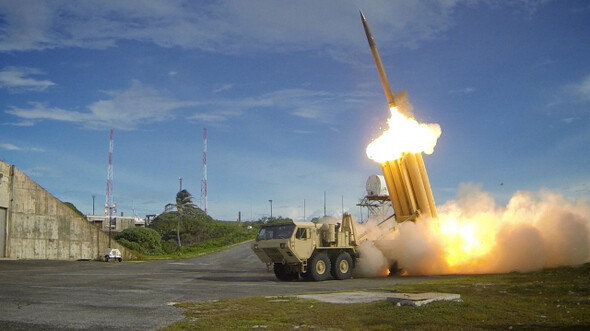hankyoreh
Links to other country sites 다른 나라 사이트 링크
Report: THAAD a hot topic of discussion, but still not fully developed

The deployment of a US Terminal High Altitude Area Defense (THAAD) system on the Korean Peninsula may be the focus of a fierce debate in South Korea, but the strategic weapon itself is still not fully developed, according to a US Defense Department official.
Michael Gilmore, director of the Operational Test and Evaluation Directorate of the US Department of Defense, stated in a written report on Mar. 25 to the Senate Armed Services Committee that the US military had succeeded in nine interception experiments with THAAD to date, but argued that the system lacked the reliability it needed for operation in the field.

“Analyses of data from the Reliability Confidence Test and multiple flight tests suggest that THAAD system components are not exhibiting consistent or steadily increasing reliability growth between test events,” Gilmore wrote in his report.
“The tools and diagnostic equipment available to Soldiers are insufficient to accurately emplace, maintain, and assess the operational status of THAAD equipment,” he added.
The weapon system also showed weakness in ability to adapt to different natural environments, Gilmore said. In particular, he noted “deficiencies during natural environment testing, which tests a system’s ability to withstand expected temperature extremes, temperature shock, humidity, rain, ice, snow, sand, and dust.”
“The deficiencies need to be addressed to ensure THAAD is capable of operating properly when and where it is needed,” he added.
Another issue cited was a lack of training for THAAD soldiers, with Gilmore referred to as a “primary concern to me.”
Complaining that operators were being sent to THAAD units without adequate training support, Gilmore stressed that THAAD is a complex system made to operate in actual combat areas with the Aegis Ballistic Missile Defense System or other missile defense systems such as the Patriot system.
“THAAD operators commented on the lack of opportunities to train with THAAD in an operationally realistic environment alongside other missile defense systems,” Gilmore said.
A total of ten ballistic missiles were intercepted by the US military in nine tests between 2007 and 2013, including eight short-range and two medium-range targets, Gilmore explained.
The US military currently has four THAAD units in position, one of which was deployed to Guam in 2013 as a measure against a possible strike by North Korea’s medium-range Musudan missile.
By Park Hyun, Washington correspondent
Please direct questions or comments to [english@hani.co.kr]

Editorial・opinion
![[Column] Park Geun-hye déjà vu in Yoon Suk-yeol [Column] Park Geun-hye déjà vu in Yoon Suk-yeol](https://flexible.img.hani.co.kr/flexible/normal/500/300/imgdb/original/2024/0424/651713945113788.jpg) [Column] Park Geun-hye déjà vu in Yoon Suk-yeol
[Column] Park Geun-hye déjà vu in Yoon Suk-yeol![[Editorial] New weight of N. Korea’s nuclear threats makes dialogue all the more urgent [Editorial] New weight of N. Korea’s nuclear threats makes dialogue all the more urgent](https://flexible.img.hani.co.kr/flexible/normal/500/300/imgdb/original/2024/0424/7317139454662664.jpg) [Editorial] New weight of N. Korea’s nuclear threats makes dialogue all the more urgent
[Editorial] New weight of N. Korea’s nuclear threats makes dialogue all the more urgent- [Guest essay] The real reason Korea’s new right wants to dub Rhee a founding father
- [Column] ‘Choson’: Is it time we start referring to N. Korea in its own terms?
- [Editorial] Japan’s rewriting of history with Korea has gone too far
- [Column] The president’s questionable capacity for dialogue
- [Column] Are chaebol firms just pizza pies for families to divvy up as they please?
- [Column] Has Korea, too, crossed the Rubicon on China?
- [Correspondent’s column] In Japan’s alliance with US, echoes of its past alliances with UK
- [Editorial] Does Yoon think the Korean public is wrong?
Most viewed articles
- 1[Column] Park Geun-hye déjà vu in Yoon Suk-yeol
- 2N. Korean hackers breached 10 defense contractors in South for months, police say
- 3Will NewJeans end up collateral damage in internal feud at K-pop juggernaut Hybe?
- 4Kim Jong-un expressed ‘satisfaction’ with nuclear counterstrike drill directed at South
- 5[Editorial] New weight of N. Korea’s nuclear threats makes dialogue all the more urgent
- 6[Cine feature] A new shift in the Korean film investment and distribution market
- 7[Column] ‘Choson’: Is it time we start referring to N. Korea in its own terms?
- 8[Column] The clock is ticking for Korea’s first lady
- 9[Editorial] Japan’s rewriting of history with Korea has gone too far
- 10Thursday to mark start of resignations by senior doctors amid standoff with government